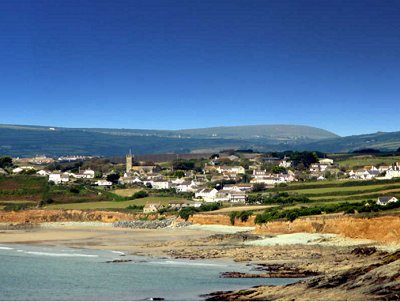


Quiet and pretty village
Web: www.visitcornwall.com/things-to-do/beaches/perranuthnoe-beach
Perranuthnoe is a civil parish and a village in south-west Cornwall. The parish population at the 2011 census was 2,184. The village is situated on the east side of Mount's Bay approximately one mile east of Marazion and four miles east of Penzance. Parts of the village has views of St. Michael's Mount and it is only a short walk down to the beach of Perran Sands.
The first historical mention of Perranuthnoe can be found in the Domesday Book of 1086, as Odenol. By 1235 this had become Hutheno, and was recorded as Udno in 1308 and 1373. Finally taking the form Uthnoe-veor in 1839. There is still a farm in the village called Ednoe-vean.
Prussia Cove, just to the east and in this parish, was home to perhaps the most famous 17th century family of Cornish smugglers, the Carters. John Carter, the eldest son, named the cove Prussia Cove, because of his deep admiration for Fredrick the Great, King of Prussia. John Carter himself became known as the King of Prussia, as he engaged in ever more daring encounters with the revenue. Although John Carter's cottage was demolished in 1906, the cove still holds the romance of its notorious connections with wrecking and smuggling.
The parish church is first mentioned in 1348, by which time transepts with pointed arches had been added. Like most churches in Cornwall, the original church was probably a small building with two cells, a chancel and nave and is one of three churches in Cornwall dedicated to St. Piran. By around 1500 a three-stage un-buttressed tower and aisle on the north side had been added and the bells are dated 1636, 1688 and 1832. By 1881 the church was in a dilapidated state and all the pews, benches, etc. were removed.
The church acquired an additional patron saint – St. Nicholas – in 1856, today replaced by St. Michael. A 1980 painting of the legends of St. Piran by local artist Rosemary Ziar and modern sculpture of St. Piran created by Annie HenryHolland and dedicated by Bishop Bill Ind in 2008 can be found in St. Nicholas chapel in the south transept.
In recent years much has been done to restore the church to its former beauty. In 1926 the chancel screen, choir stalls and reredos were added in memory of a former general manager of the Great Western Railway, while the altar and communion rails commemorate the longest serving incumbent, Rev. Richard Astley (1850-1902), and his wife. Reredos figures included St. Piran and his millstone. In 1937 the Chapel of St. Nicholas, in the south transept, was restored to use in memory of Canon Purves, and in 1952 Miss C.C. Astley presented a new font cover to the church. On the east wall of the tower there is a chiming clock given in memory of Eliza Trevelyan in 1913, which was restored by public subscription in 1984 and its face repainted and gilded in 1999.
During the 18th and 19th century the landscape surrounding the village supported a number of tin and copper mines the last of which closed in 1900.
With the coming of John Wesley, chapels were built in Perranuthnoe, Goldsithney and Trevean in the early 1900's. The one at Trevean was granted to John Wesley himself and he refers to it in his Journal as the chapel on St. Hiliary Downs. The Weslyan Chapel in Goldsithney has recently been rebuilt and the Chapel in Perranuthnoe is now a family dwelling.
The barque 'Saluto' was wrecked at Cudden Point, Perranuthnoe, in December 1911.
Just to the east at Acton Castle, John Stackhouse (1742-1819) lived. He became a Fellow of Exeter College, Oxford at the age of nineteen. When twenty one he inherited the Pendarves estates near Camborne. He built Acton Castle at Cudden Point during 1775, specifically to research the seaweeds there.
Marazion Penzance Praa Sands St. Michael's Mount
The Coastal Footpath Cornwall's Beaches Acton Castle